I’m not in it for the honey.
A refrain I’ve repeated for a year and a half. Bees are the most incredible creatures. I think humans are hard-wired to find fascinating what bees are hard-wired to do. A social insect, forming colonies from which intelligent behaviour seems to emerge. An insect which, on an individual basis seems to have enough character to be charming, but when viewed in great numbers is inescapably prone to anthropomorphism.
Would humanity have had such a sustained interest in the behaviour of bees had honey not been part of the equation? Probably not. Would I have been in a position to acquire a colony of honeybees without the ancient history of apiculture? Certainly not. But from swerve of shore to bend of bay, I have a colony of bees. I’m not in it for the honey.
It’s been a bit of a year all round. I would have liked to pay them more attention. Bees do perfectly well in the wild, although the life of a wild colony is less perennial, but when one houses a colony and puts them in a box alongside which they did not evolve, one takes responsibility for the shortfall in atavistic authenticity. They seem to be very happy and productive in their box, and probably live longer than they would in the wild. But disease is a fact of life and when animals are snatched from nature’s teeth and claws, they must be looked after. I did treat them for varroa mites, as pretty much every beekeeper must, and my colony seem to be strong and disease-free. But I did notice queen cups, which signal the arrival of queens, and around the time that they might have swarmed, I was either spending all my time planning to get married, or getting married, or recovering from it. I’m sure I missed a swarm. I hope some lucky local beekeeper found them. They’re good bees. If they did swarm, the remaining colony is good and strong, so no harm done.
The weather has been profoundly weird, and last weekend was sunnier than by rights I thought it ought to have been. I paid a visit to my hive and they were very much making the most of things. A joy to watch as ever.
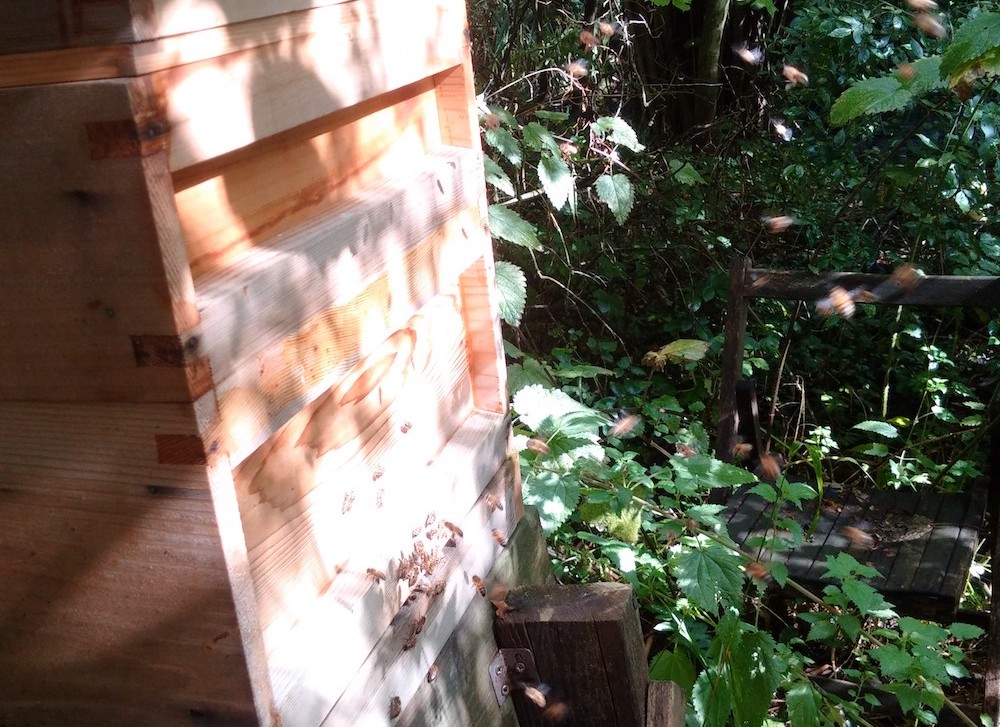
Nature’s lack of purpose
Bees in the wild would make one or two combs and build, occupy, raise young and fill with stores, in that order, according to a characteristic and fascinating pattern. The branch or hollowed out trunk of a tree has no purpose, and certainly not one involving the bees. The comb has a purpose though, and the evolution in behaviour that has led to bees’ making it has been driven by the need for their genes to survive.
A man-made beehive is under no illusions about the purpose it serves. The evolutionary behaviour that has led to the occurrence of beehives is a little more complicated, but can be summarised as ‘it’s nice to eat honey’. The purpose of the comb (from the bees' point of view) in a man-made beehive is still the same: to keep the colony alive long enough to pass on the genes to the next generation. The structure in which it is built, however, has a strong and overriding purpose: to encourage the bees to produce as much accessible honey as possible.
These two purposes are in opposition. They intersect rather neatly in the manifestation of bridge comb. This is comb in places where bees think it perfectly sensible to have comb but humans don’t. Individual frames are designed to be removed, not only for the extraction of honey, but also for inspection of comb, larva, pupa and bees for indications that they are free of disease and stress. When bridge comb is found it must be removed or it becomes impossible not only to collect honey, but also to fulfil one’s obligation to take care of a colony that has been displaced from nature.
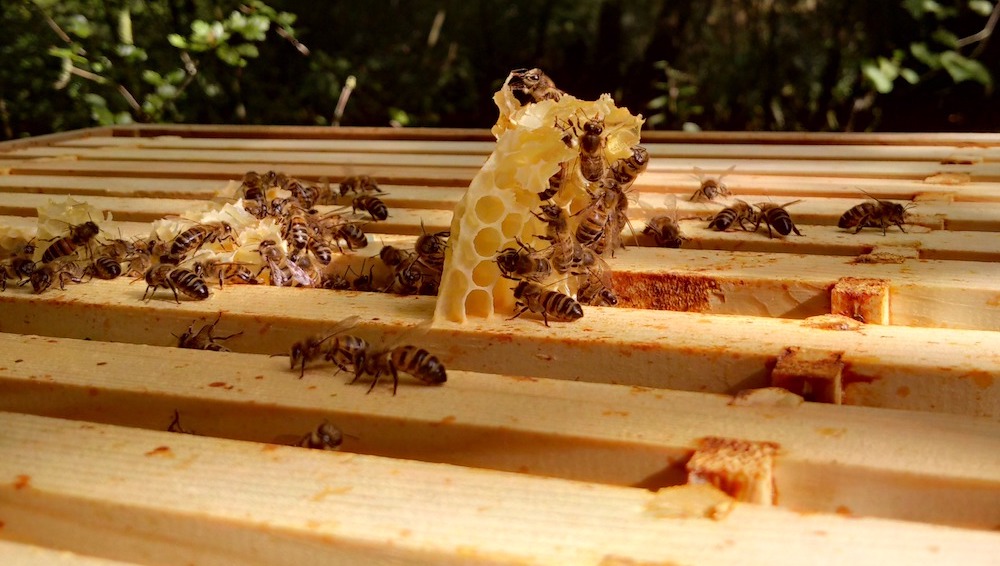
I found a fairly substantial and well-engineered bridge comb. It spanned two frames, from top to bottom. It also joined vertically at the top and the bottom, in several places.
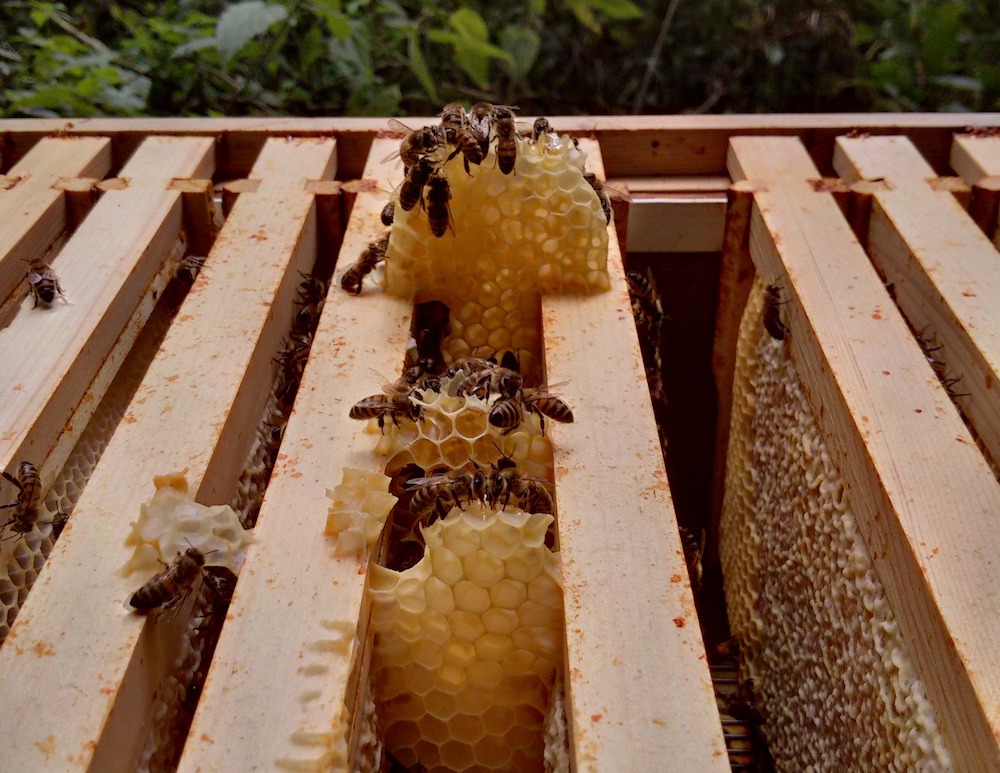
Some of it was empty but some had honey in, safely stored away for winter. Sad though it was, I had to remove it.
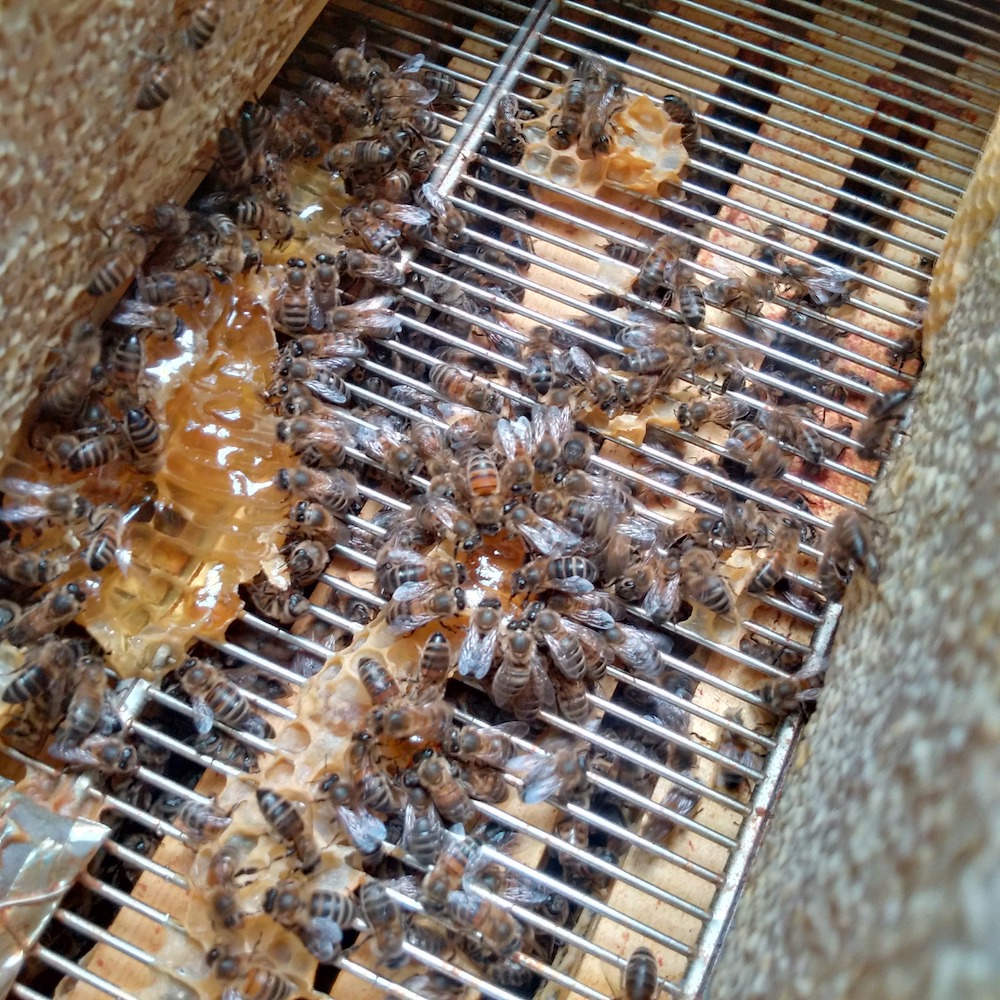
The bees formed a huddle around the spilled honey and tried to rescue as much of it as possible. You may know, and may or may not want to know, that nectar is transported back from plants in a special honey stomach. Along its journey from watery nectar to proper honey, it is also shifted round the hive, for whatever reason, the same way. When these workers started eating the spilled honey they weren’t doing it for their own benefit (questions of altruism aside).
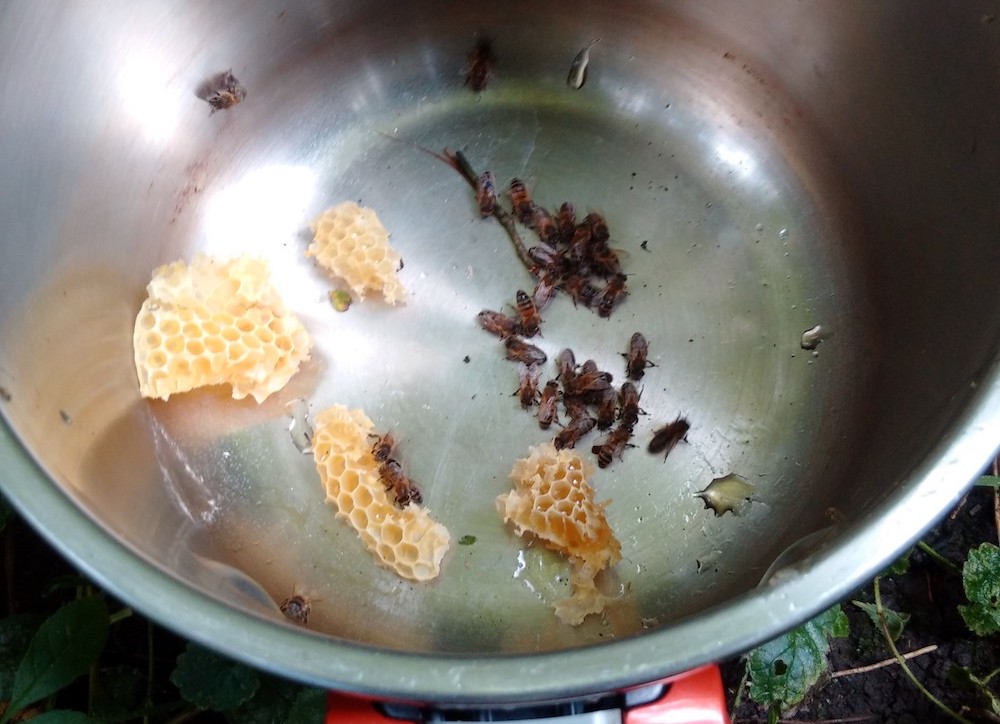
I let the bees recover as much honey as possible from the comb taking it away. The honey in there wasn’t cured, so it wouldn’t have been fit for human consumption.
There are many traditional sayings about bees most of which can be translated roughly as ‘we don’t understand them’. Why would they put so much effort into building and filling brace comb in the middle of the hive when there’s perfectly good empty foundation ready to be drawn out and filled in a neat orderly manner elsewhere in the hive?
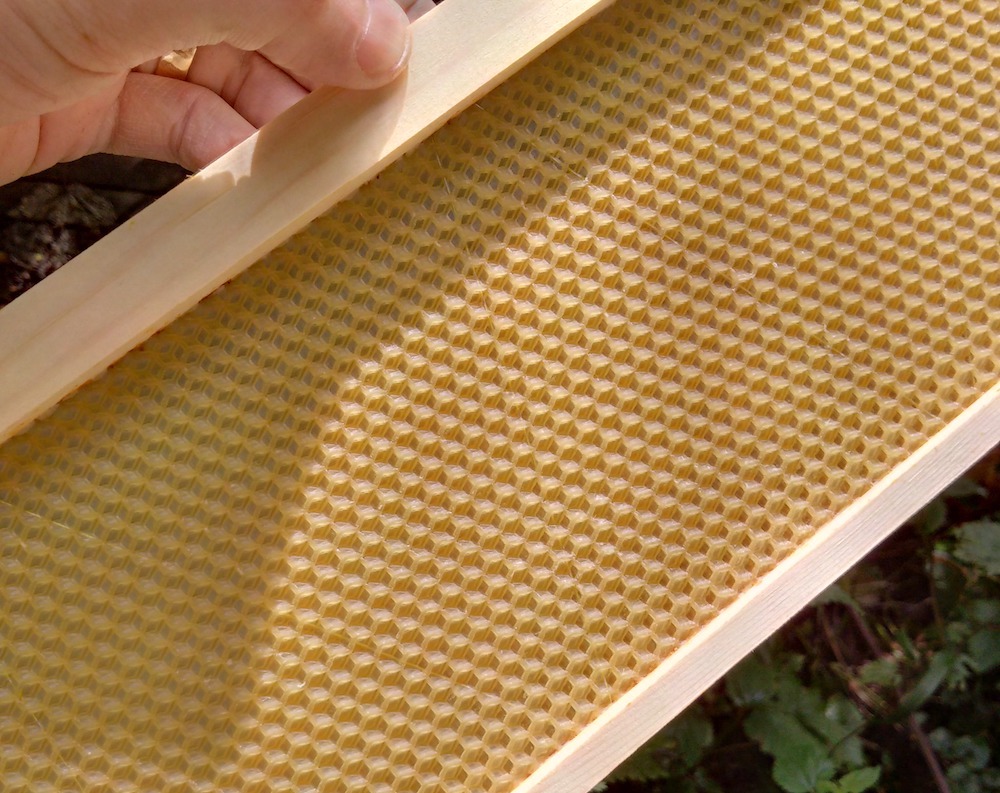
The answer is more or less ‘because they don’t want to’. Reasons for this can be that they’re not comfortable in that part of the hive because it’s the wrong temperature, or because it doesn’t have the right ventilation, or because they just haven’t discovered it and haven’t had the reason to be curious enough. I prefer to think it’s for an altogether more inaccessible reason.
I found some parts of my hive devoid of honey, let alone comb, the foundation (which has been there months) completely untouched. Other parts had partial stores, with a mixture of capped, cured, honey and partially cured nectar.

And there were a handful of fully capped combs, ready for eating later. I decided that one of the combs was ready for me to eat later and the rest were for the bees.
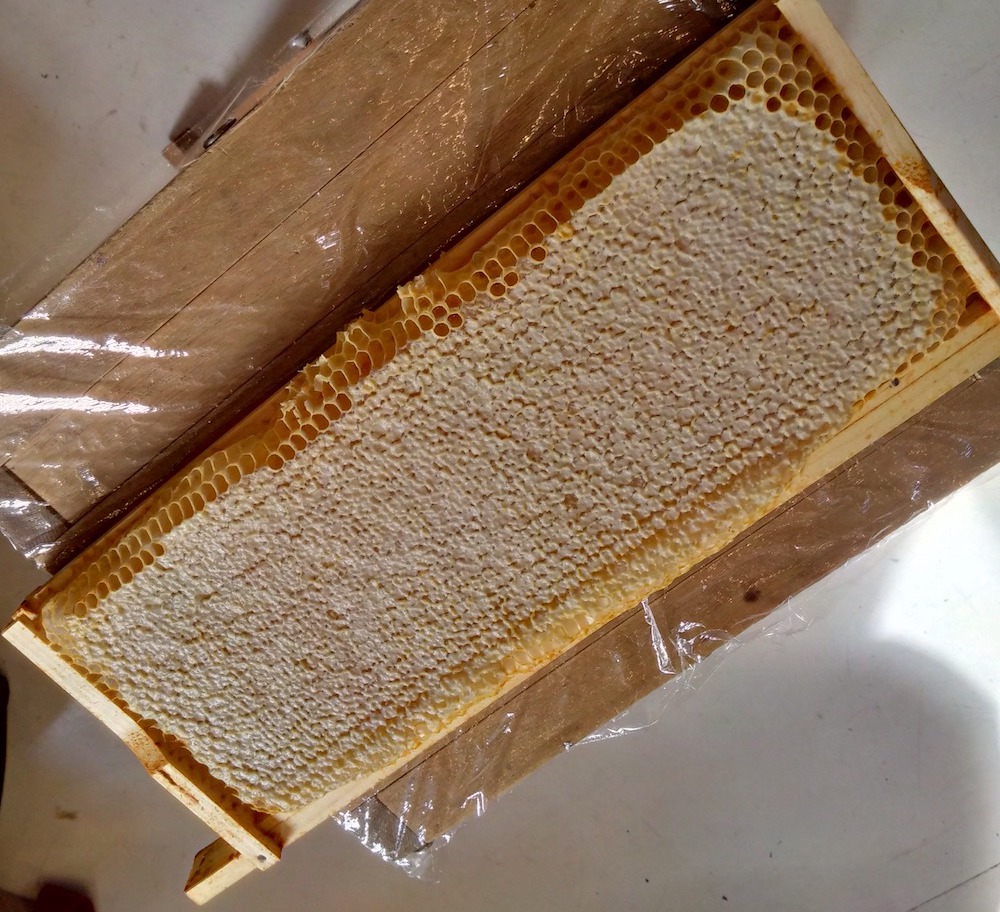
First honey
This is the first time I have taken honey. There are all kinds of tips and tricks for efficient removal of honey, but efficiency has never appealed to me and it seemed wrong to trivialise the reversal of what is an literally unimaginable amount of effort.
I strung the comb up over a mixing bowl in the sink and de-capped the honeycomb.
In the process of destroying bridge comb I had indulged vague concepts like ‘husbandry’. The cognitive dissonance involved in destroying the part of my bees' home because I knew better enabled me to do it with sound conscience. But in decapping this honey, no such hand-waving was possible. I was doing this out of greed.
Running a knife along the comb, just under the wax cappings felt very much like an act of violence. If you want to know how much honey a bee produces in a lifetime the statistics are out there and easily located. It’s not very much. Hundreds, maybe thousands of bees lived and died to create this store of energy, solely to allow their mother and half-sisters to survive the winter. Summer bees work hard and die young, having given their lives for the sake of their genes. Winter bees live longer and put all their effort into keeping the colony going over winter.
Most animals sacrifice their lives for the sake of their offspring, one way or another. The interesting thing about social insects like bees is that the workers have no offspring, just other half-sisters who will look after younger half-sisters.
I fed my bees sugar syrup over winter, and I will do again. But it’s no quid pro quo for honey. There is a huge imbalance.
This all notwithstanding, it was very exciting collecting my first honey. I scraped both sides of the comb and it filled the bowl up far more than I had expected.
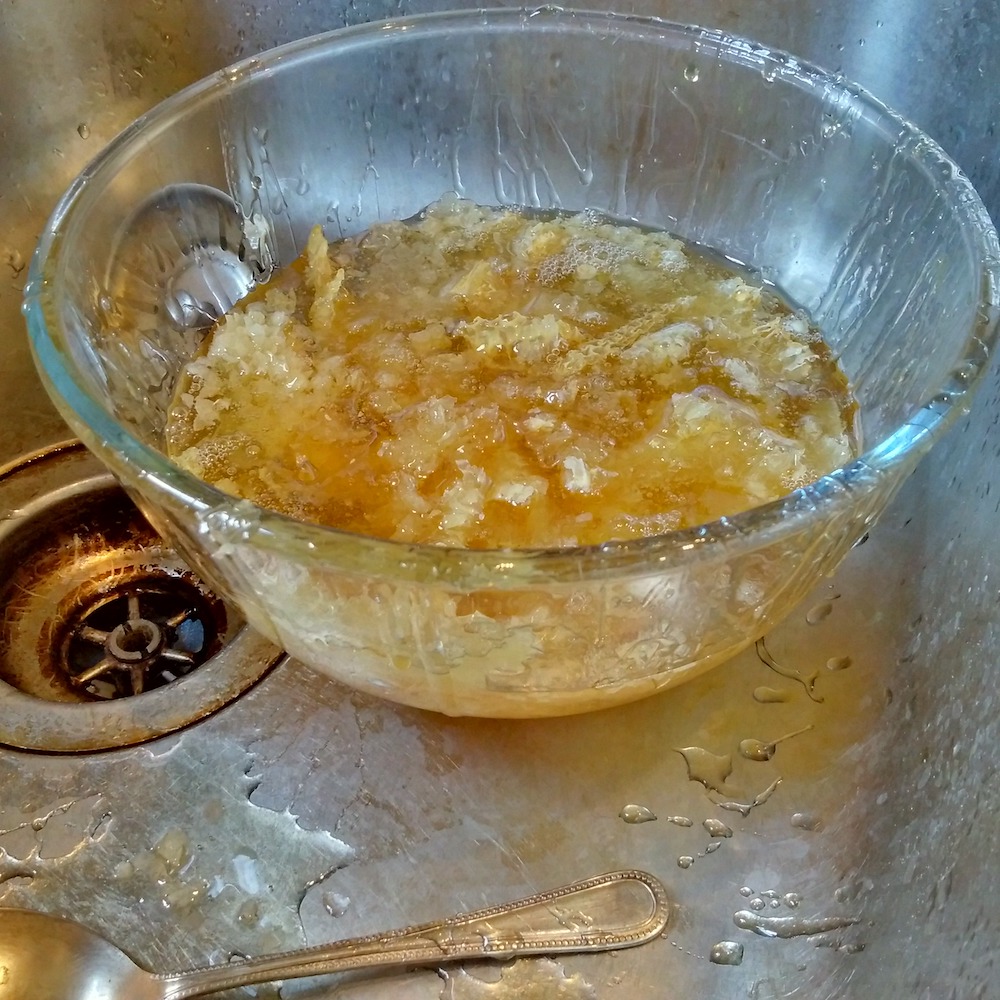
I ended up scraping all of the honeycomb and honey into the bowl, then let the remainder drip out.
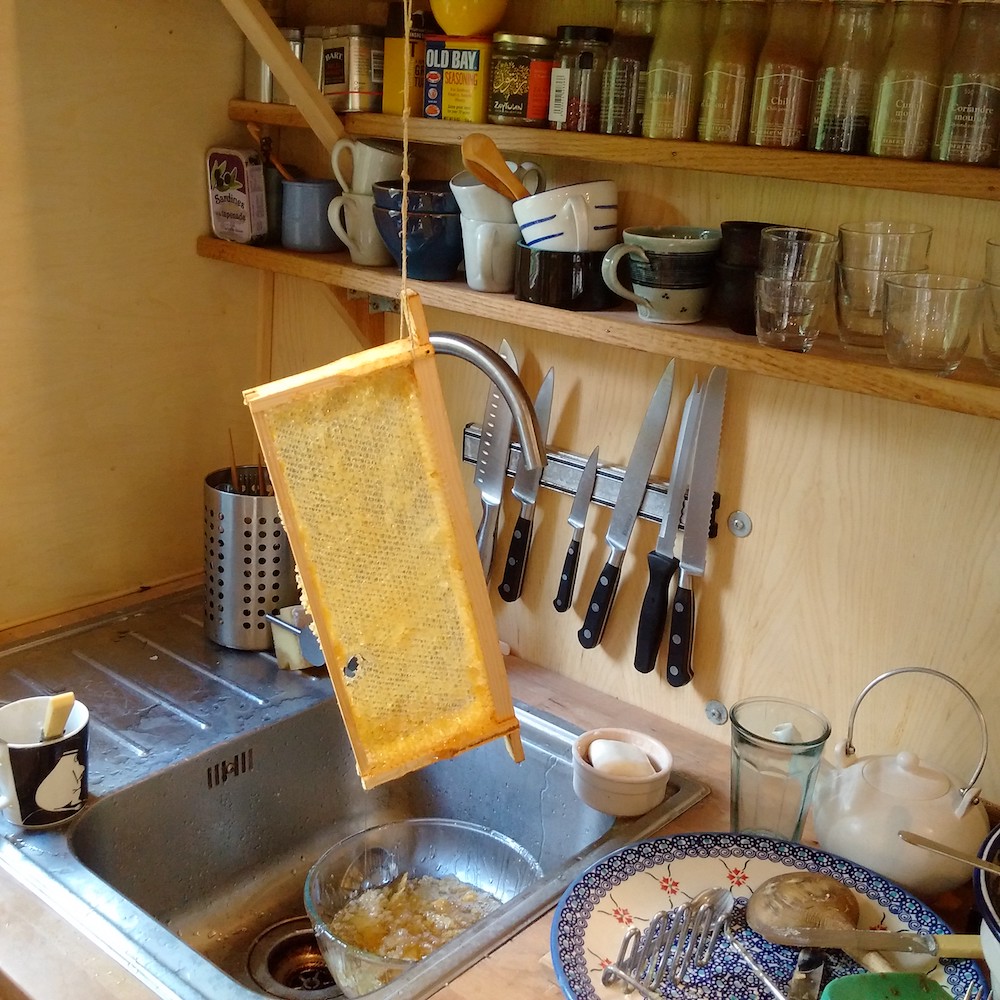
The honey and comb went into a well-sterilised linen straining bag. The unexpected volume from the comb was a mixture of honey and wax comb, but it was difficult to tell how much of each there was.
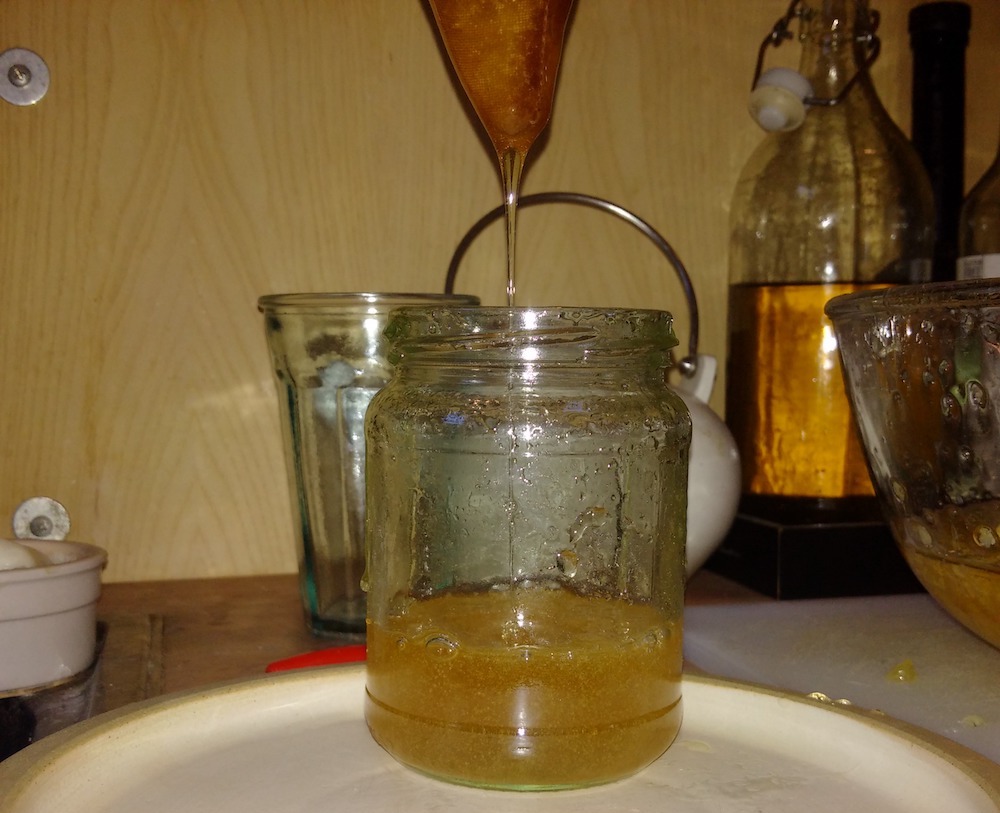
I ended up filling nearly three jars. I kept some comb in one of them. The honey that my bees make is very floral, light in colour and taste, with a hint of menthol. It’s very fluid.
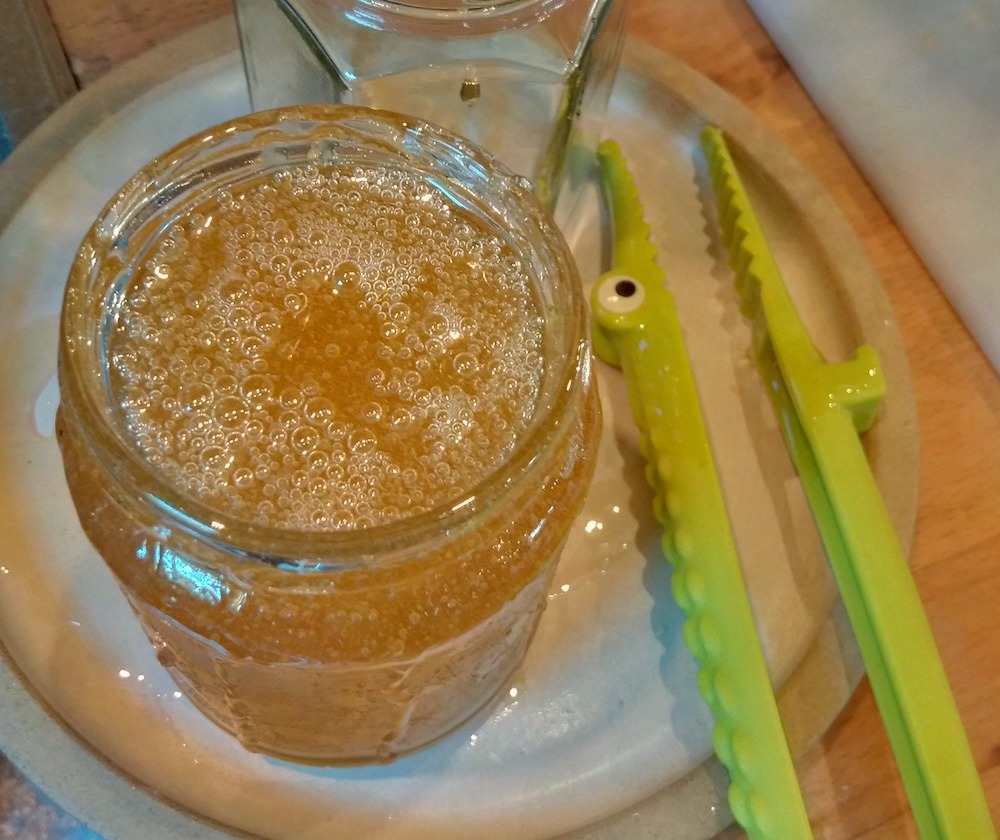
I have my first honey. It is sacred. I’m not sure what we’ll do with it. Any use I can think of seems too trivial.
Bee grit
What remained, after a thorough straining, was a mixture of wax, propolis, remaining honey and what my wife called ‘bee grit’. I had on hand some bridge comb that I had extracted earlier in the year (in the glass). It had a much lighter colour. The dark red marks are propolis, which is made of a mixture of things including tree sap. The proplis that my bees make is very dark and incredibly sticky. It’s almost impossible to get off things.
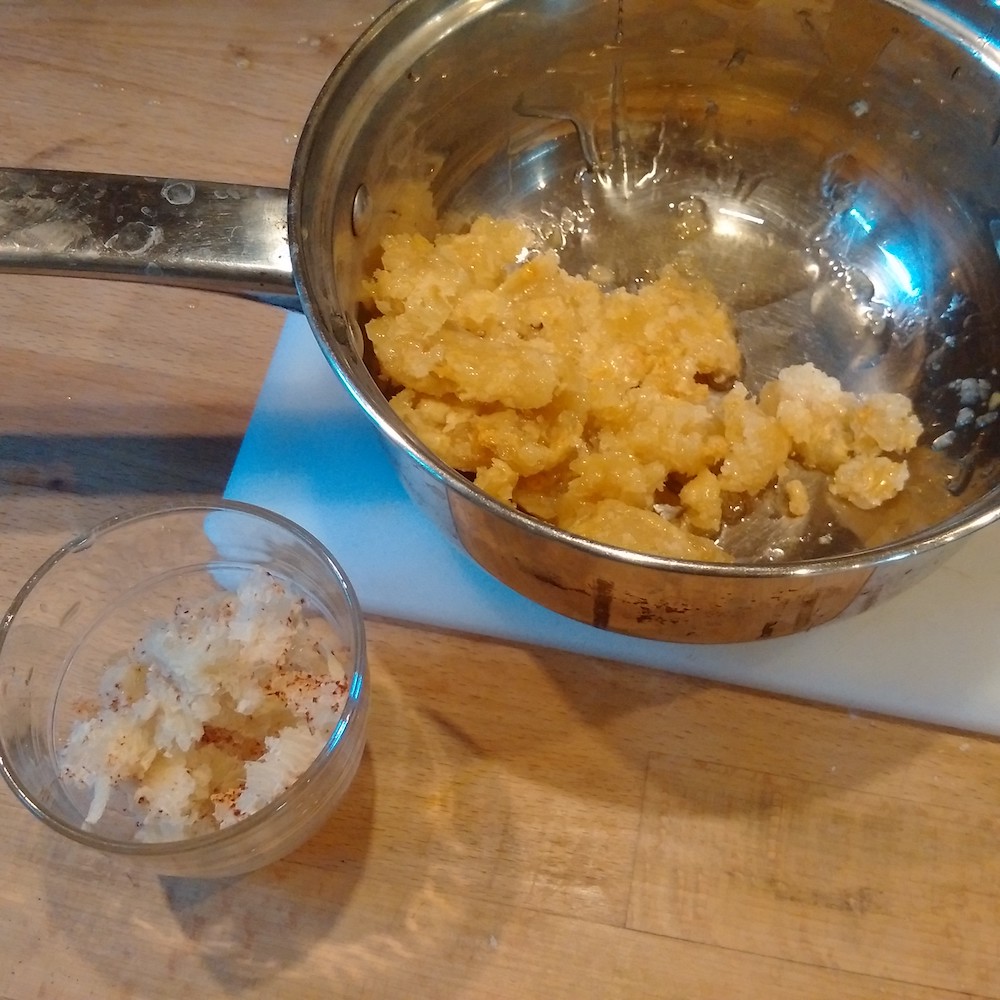
Credible advice suggested that once a container has been used for beeswax it won’t ever be used for anything else. I’m not ashamed to say that I was abe to find an empty John Smith’s can without much difficulty. I made a bain marie and melted the mixture down.

I had a difficult time reconciling the volume of liquid in the bowl with the volume of honey in the jars plus the volume of wax. I’m sure it has something to do with the ratio of 2πr2 to 4/3 πr3. I melted the mixture down.

After letting it set, the remainder was about one part liquid, one part bee grit and one part pure beeswax.
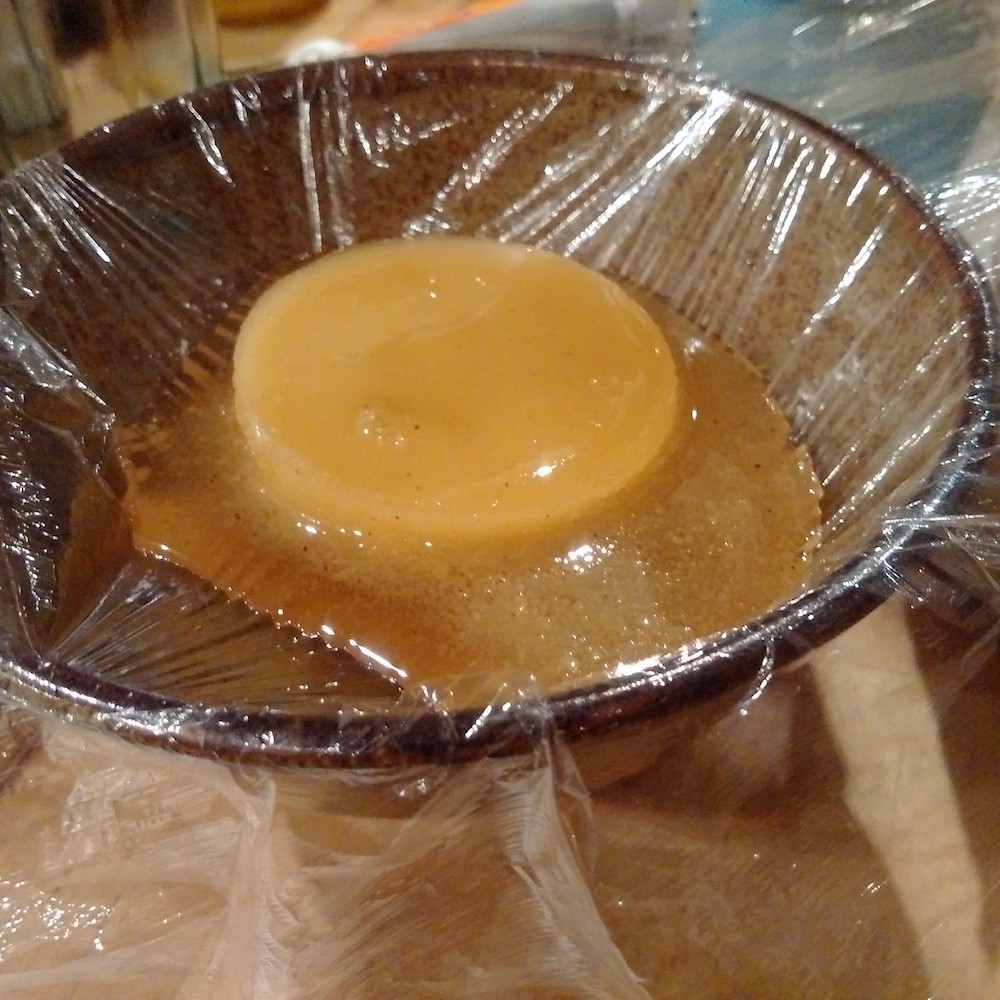
There are a number of noble ways that beeswax can be put to use.
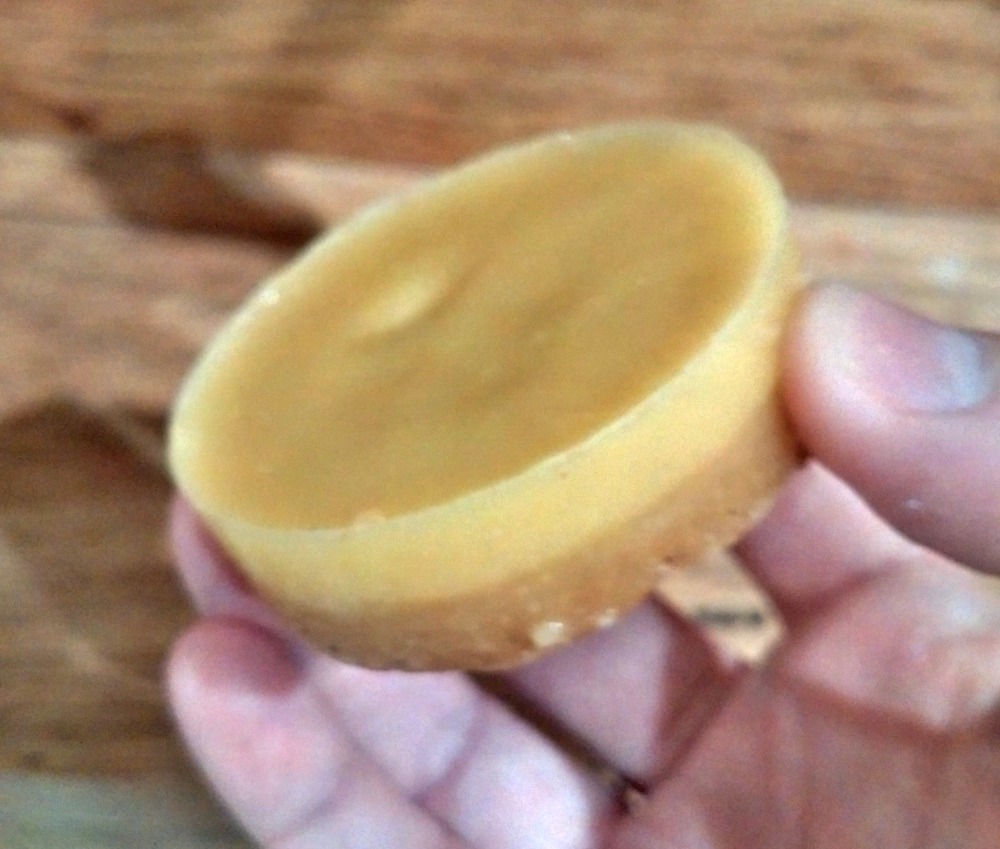
As for bee grit? Suggestions welcome.